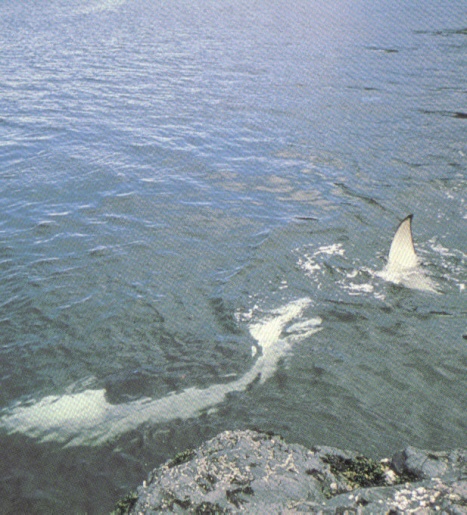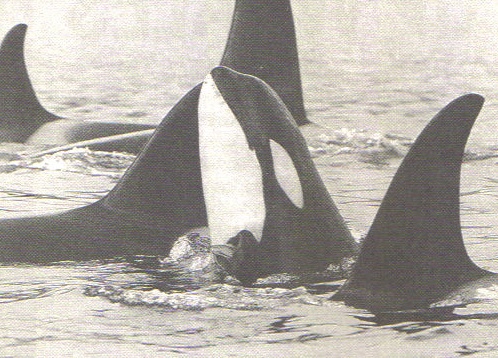

Orcas are very active creatures: they swim, leap, dive, etc. But there's a whole other language when it comes to talking about them. Don't know what a spyhop is? Don't know how to say they jumped in proper orca-form? Read on!
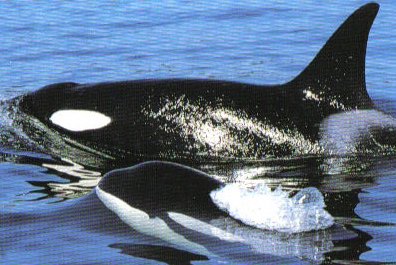
Traveling
The most basic form of moving, traveling is when the pod of orcas are just swimming along. Typically when traveling, orcas do not stop to socialize, but move determinedly along. Often, the whales stay fairly close together when traveling. Travelling whales can move 5 knots and up.
Above: Two orcas, scanned from Killer Whales by Mark Carwadine.

Resting/Sleeping
Orcas, like all dolphins, can't fully sleep. If they did, they would die. You know how if you hold your breath for a long time, and then you forget to not breathe, your body just does it for you? We can't help breathing. But orcas and other dolphins have to think about each breath. If they went to sleep, they'd drown. So what they do is half their brain sleeps at a time. When sleeping, orcas will make lines and just go in a straight path, sometimes 'pacing' up and down one area. The sleeping times usually last about 45 minutes. Orcas are generally unaware of much when they're 'sleeping'. In fact, once a pod of whales entered a strong current and were pushed backwards for half an hour before they woke up and figured it out! When orcas just rest, they move slowly and calmly, while some whales might play around them.
Above: A group of Residents resting, scanned from Killer Whales by John Ford, Graeme Ellis and Kenneth Balcomb. Often, when pods get together, they socialize and play very energetically, and then rest together, as these pods are doing.

Porpoising
When orcas move fast (usually above 5 knots), they sometimes 'porpoise'. This when they move so fast, they come out of the water with each breath. Occasionally they even clear the surface. Porpoising can occur during travelling, or during an exciting hunt.
Above: A young orca porpoising, scanned from Orca: The Whale Called Killer by Erich Hoyt.

Bow-riding
There are many species of whales and dolphins who bow-ride. Bow-riding is when a whale or dolphin rides the wake behind a boat, surfing and playing in the waves directly behind the boat. Smaller dolphins do this commonly, while a few instances have seen humpbacks ride the wake. Orcas are in the middle-they will sometimes bow-ride, but not for long, and not the whole pod. Younger orcas are usually the ones who bow-ride.
Above: A young orca bowrides, scanned from Killer Whales by John Ford, Graeme Ellis and Kenneth Balcomb.

Breaching
There are few sights as spectacular as an orca breaching. Breaching is just the whale-word for jumping. In the wild, orcas typically breach and fall on their back or side, but in captivity, they are trained to jump forwards, bend, and go right back down. This is called a 'bow'. No one knows why orcas breach-some scientists say to communicate, some say to get rid of unwanted parasites on the skin. But, since breaching occurs most when the orcas are socializing, most think they just do it for fun!
Above: An orca breaching, from Orca: Visions of a Killer Whale by Peter Knudsten.
Below: Takara, a captive-born orca, performs a 'bow'. This picture was taken by Laurie Neron, and cannot be used without PERMISSION!
More captive behaviors HERE

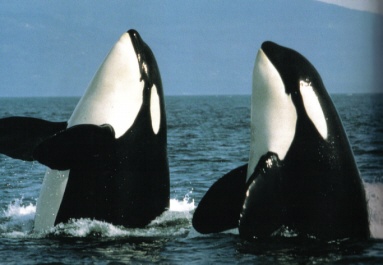
Spy-hopping
Spy-hopping is a common behavior (especially among Norwegian orcas). It is when an orca lifts its head out of the water, somtimes going so far as too lift its entire upper body out. Orcas typically do this to take a look around, and it often occurs during socializing, or just after a rest. Almost as though they're making sure everyone's there! Orcas have very good eyesight above and below water.
Above: Two orcas spy-hop, scanned from Orca: Visions of a Killer Whale by Peter Knudsten.

Playing with kelp
The title says it all. Orcas' favourite 'toys' are kelp. They drape it around their dorsal fin and tow it around, they lift it and throw it with their tails, they swim through it. Especially young orcas, but everyone gets in on the fun.
Above: An orca lifts some kelp with its tail, scanned from Killer Whales by John Ford, Graeme Ellis and Kenneth Balcomb.
Below: Taku (K1) swims with kelp draped over his fin in a photo taken by Stefan Jacobs. Copyright to Stefan Jacobs.
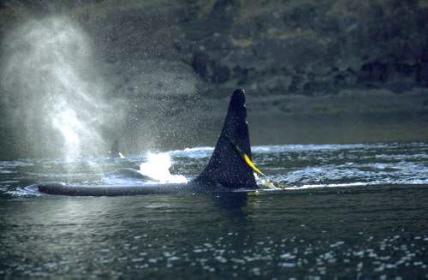
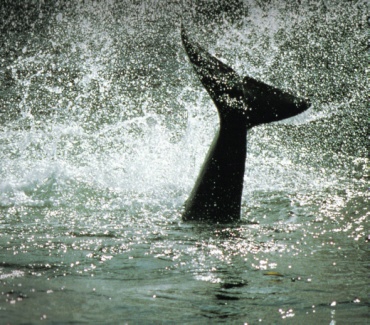
Tail-Lobbing/Lobtailing/Tail-Slapping
Again, the title says it all. There are many names for this behavior, but they all pretty much sum it up. This action is when an orca slaps its tail against the surface. It can get pretty loud, so some scientists think its probably a method of communication. The whales might also be trying to get rid of unwanted parasites, or they might just enjoy slapping the water!
Above: An orca gives a mighty slap with its tail, in a photo scanned from Killer Whales by John Ford, Graeme Ellis and Kenneth Balcomb.

Flipper Slapping
Orcas often flipper-slap, which is when they raise one pectoral flipper above the surface and slap it on the water. The sound can travel a kilometre under water. Like other socializing activities, we don't really know the use of flipper-slapping. Of course when the males do it, with their huge pectoral fins, its very impressive!
Above: A young resident orca flipper-slaps, scanned from Killer Whales by John Ford, Graeme Ellis and Kenneth Balcomb.

Mother/Calf Position
When travelling, or just swimming along, mothers and their calves swim in the aptly-named mother/calf position. Calves stay tucked in right next to their mothers, or directly beneath one of their pectoral fins. When beside them, this means the calves can catch the wake of their mothers, which helps them keep up with the rest of the faster pod. This position is also ideal for the orca baby to nurse.
Above: A Southern Resident calf rides its mother's wake, copyright to Stefan Jacobs.

The Rubbing Beaches
Northern Residents in BC flock to the Rubbing Beaches at Robson Bight (Michael Bigg) Ecological Reserve in the summer. The world's first ecological reserve specifically for orcas, the Rubbing Beaches are pebble beaches which over the years have developed deep gourges in them. Why? They're an orca massage parlor! Orcas come to the rubbing beaches to rub and roll on the pebbles. They come within 5 feet of the shore. The rubbing beaches are clearly very important to them, and access to them is now restricted.
Above: An orca beach-rubs at Robson Bight, scanned from Killer Whales by John Ford, Graeme Ellis and Kenneth Balcomb.
Below: A superb photo of orcas at the Rubbing Beaches, scanned from the April 2005 National Geographic issue.
Bottom: An orca from above the surface, enjoying the rubbing beaches, scanned from Orca: The Whale Called Killer by Erich Hoyt.

